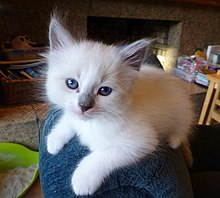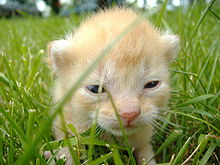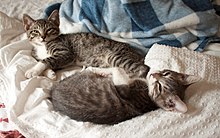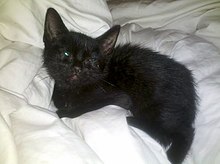Kitten

Akittenis ajuvenilecat.After being born, kittens display primaryaltricialityand are fully dependent on their mothers forsurvival.They normally do not open their eyes for seven to ten days. After about two weeks, kittens develop quickly and begin to explore the world outside their nest. After a further three to four weeks, they begin to eat solid food and grow baby teeth. Domestic kittens are highly social animals and usually enjoy human companionship.
Etymology
The word "kitten" derives from theMiddle Englishwordkitoun,which in turn came from theOld Frenchchitounorcheton.[1]Juvenilebig catsare called "cubs" rather than kittens; either term (but usually more commonly "kitten" ) may be used for the young of smaller wildfelids,such asocelots,caracals,andlynxes.[2]
Development



A felinelitterusually consists of two to five kittens,[3]but litters with one to more than ten are known.[4]Kittens are typically born after agestationlasting between 64 and 67 days, with an average length of 66 days.[3]When they are born, kittens emerge in a sac called theamnion,which is bitten off and eaten by the mother cat.[5]
For the first several weeks, kittens cannoturinateordefecatewithout being stimulated by their mother.[6]They also cannot regulate their body temperature for the first three weeks, so kittens born in temperatures less than 27 °C (81 °F) can die fromhypothermiaif their mother does not keep them warm.[7]The mother's milk is very important for the kittens' nutrition and proper growth. This milk transfersantibodiesto the kittens, which helps protect them againstinfectious diseases.[8]As mentioned above, they cannot urinate, so they have a very high requirement for fluids.[9]Kittens open their eyes about seven to ten days after birth. At first, theretinais poorly developed and vision is poor. Kittens cannot see as well as adult cats until about ten weeks after birth.[10]
Kittens develop very quickly from about two weeks of age until their seventh week. Their coordination and strength improve, and theyplay-fight with their litter-mates and begin to explore the world outside the nest or den. They learn to wash themselves and others as well as play hunting and stalking games, showing their inborn ability as predators. These innate skills are developed by the kittens' mother or other adult cats, who bring live prey to the nest. Later, the mother demonstrates hunting techniques for the kittens to emulate.[11]As they reach three to four weeks old, the kittens are graduallyweanedand begin to eat solid food, with weaning usually complete by six to eight weeks.[12]Kittens generally begin to lose theirbaby teetharound three months of age, and they have a complete set of adult teeth by nine months.[13]Kittens live primarily on solid food after weaning, but usually continue to suckle from time to time until separated from their mothers. Some mother cats will scatter their kittens as early as three months of age, while others continue to look after them until they approachsexual maturity.[14]
The sex of kittens is usually easy to determine at birth. By six to eight weeks this becomes harder because of the growth of fur in the genital region. The male'surethral openingis round, whereas the female's urethral opening is a slit. Another marked difference is the distance betweenanusand urethral opening, which is greater in males than in females.[15]
Kittens are highly social animals and spend most of their waking hours interacting with available animals and playing on their own. Play with other kittens peaks in the third or fourth month after birth, with more solitary hunting and stalking play peaking later, at about five months.[16]
Kittens are vulnerable because they like to find dark places to hide, sometimes with fatal results if they are not watched carefully. Cats have a habit of seeking refuge under or inside cars or on top of car tires during stormy or cold weather. This often leads to broken bones, burns, heat stroke, damaged internal organs or death.[17]
Domestic kittens are commonly sent to new homes at six to eight weeks of age, but it has been suggested that being with their mother and litter-mates from six to twelve weeks is important for a kitten's social and behavioural development.[16]Usually, breeders and foster/rescue homes will not sell or adopt out a kitten that is younger than twelve weeks. In many jurisdictions, it is illegal to give away kittens younger than eight weeks of age.[18]Kittens generally reach sexual maturity at around seven months old. A cat reaches full "adulthood" around one year of age.[19]
Health
Domestic kittens in developed societies are usually vaccinated against common illnesses from two to three months of age. The usual combination vaccination protects againstfeline viral rhinotracheitis(FVR),feline calicivirus(C), andfeline panleukopenia(P). ThisFVRCPinoculation is usually given at eight, twelve, and sixteen weeks, and an inoculation againstrabiesmay be given at sixteen weeks. Kittens are usuallyspayed or neuteredat seven months of age, but kittens may be neutered as young as seven weeks (if large enough), especially inanimal shelters.[20]Such early neutering does not appear to have anylong-term health risks to cats,and may even be beneficial in male cats.[21]Kittens are commonly givendewormingtreatments forroundwormsfrom about four weeks.[22]

Nutrition

Felines are carnivores and have adapted to animal-based diets and low carbohydrate inclusion. Kittens are categorized in a growth life stage, and have high energy and protein requirements.[23]When feeding a kitten, it is often recommended to use highly digestible ingredients and various components to aid in development in order to produce a healthy adult.[24]In North America, diets certified by the Association of American Feed Control Officials (AAFCO) are accepted as adequate nutrition, thus kitten diets should be AAFCO approved to ensure full supplementation.[25]Key components of the diet are high fat content to meet caloric requirements of growth, high protein to meet requirements for muscle growth as well as supplementation of certain nutrients such asdocosahexaenoic acidto benefit the development of thebrainand optimization ofcognition.[26]
Pre-weaning nutrition
Establishing immunity
Part of the kitten's immune system is the mucosal immune system, which is within the gastrointestinal tract. The mucosal immune system is largely responsible for coordinating proper immune responses by tolerating innocuous antigens and attacking foreign pathogens.[27]In order to optimize kitten health and increase chances of survival, it is important to optimize the link between thegut-associated lymphoid tissueand themicrobiotaof thegastrointestinal tract.Lasting health and longevity can be accomplished partly through proper nutrition[28]and establishing a healthy gut from birth through utilizing colostrum.[29]

Within the first two days afterbirth,kittens acquirepassive immunityfrom their mother's milk.[30]Milk within the first few days of parturition is calledcolostrum,and contains high concentrations ofimmunoglobulins.[30]These includeimmunoglobulin Aandimmunoglobulin Gwhich cross the intestinal barrier of theneonate.[29]The immunoglobulins andgrowth factorsfound in the colostrum begin to establish and strengthen the weak immune system of the offspring.[31]Kittens are able to chew solid food around 5–6 weeks after birth, and it is recommended that 30% of their diet should consist of solid food at this time.[32]The kitten remains on the mother's milk until around eight weeks of age when weaning is complete and a diet of solid food is the primary food source.[23]
Post-weaning nutrition
Fat
Until approximately one year of age, the kitten is undergoing a growth phase where energy requirements are up to 2.5 times higher thanmaintenance.[33]Pet nutritionists often suggest that acommercial cat fooddesigned specifically for kittens should be offered beginning at four weeks of age.[28]Fathas a higher caloric value thancarbohydratesandprotein,supplying 9 kcal/g.[34]The growing kitten requiresarachidonicandlinoleic acidwhich can be provided inOmega -3 fatty acids.[23]Docosahexaenoic acid (DHA) is another vital nutrient that can be supplied through Omega 3 fatty acid. Addition of DHA to the diet benefits the cognition, brain and visual development of kittens.[28]
Protein
Cats are naturalcarnivoresand require high amounts of protein in the diet. Kittens are undergoing growth and require high amounts of protein to provide essential amino acids that enable the growth of tissues and muscles.[30]It is recommended that kittens consume a diet containing approximately 30% protein, on a dry matter basis, for proper growth.[35]
Taurineis an essential amino acid found only in animal tissue; the mother cat cannot produce enough of it for her kittens.[36]As it is an indispensable amino acid, it must be provided exogenously through the diet at 10 mg per kg of bodyweight, each day.[37]Kittens deprived of taurine can experience poor growth[36]and can result in retinal degeneration in cats.[38]
Carbohydrates
Felines are natural carnivores and do not intentionally consume large quantities of carbohydrates. The domestic cat's liver has adapted to the lack of carbohydrates in the diet by using amino acids to produce glucose to fuel the brain and other tissues.[39]Studies have shown that carbohydrate digestion in young kittens is much less effective than that of a mature feline with a developed gastrointestinal tract.[40]Highly digestible carbohydrates can be found in commercial kitten food as a source of additional energy as well as a source of fiber to stimulate the immature gut tissue. Soluble fibre such as beet pulp is a common ingredient used as a fibrous stool hardener and has been proven to strengthen intestinal muscles and to thicken the gut mucosal layer to prevent diarrhea.[41]
Diet composition
Amino acids
The lack of readily availableglucosefrom the limited carbohydrates in the diet has resulted to the adaptation of the liver to produce glucose from the breakdown components of protein—amino acids. The enzymes that breakdown amino acids are constantly active in cats. Thus, cats need a constant source of protein in their diet.[24]Kittens require an increased amount of protein to supply readily available amino acids for daily maintenance and for building new body components because they are constantly growing.[24]There are many required amino acids for kittens.Histidineis required at no greater than 30% in kitten diets, since consuming histidine-free diets causes weight loss.[25]Tryptophanis required at 0.15%, seeing as it maximizes performance at this level.[25]Kittens also need the following amino acids supplemented in their diet:arginineto avoid an excess of ammonia in the blood, otherwise known ashyperammonemia,isoleucine,leucine,valine,lysine,methionineas a sulfur-containing amino acid,asparaginefor maximal growth in the early post-weaning kitten,threonineand taurine to prevent central retinal degeneration.[25]
Vitamins
Fat-soluble vitamins
Vitamin Ais required in kitten diets because cats cannot convertcarotenestoretinolin the intestinal mucosa because they lack the necessary enzyme; this vitamin must be supplemented in the diet.[24][42]Vitamin Eis another required vitamin in kitten diets; deficiency leads to steatitis, causing the depot fat to become firm and yellow-orange in colour, which is painful and leads to death.[42]Also,vitamin Dis an essential vitamin because cats cannot convert it from precursors in the skin.[24]
Water-soluble vitamins
Cats can synthesizeniacin,but their breakdown exceeds the rate that it can be synthesized and thus, have a higher need for it, which can be fulfilled through an animal-based diet.[24]Pyridoxine(vitamin B6) is required in increased amounts because it is needed to produce amino acids.[24]Vitamin B12is an AAFCO-recommended vitamin that is essential in the metabolism of carbohydrates and protein and maintains a healthy nervous system, healthy mucous membranes, healthy muscle and heart function, and, in general, promotes normal growth and development.[42]Cholineis also a AAFCO recommended ingredient for kittens, which is important forneurotransmissionin the brain and as a component of membranephospholipids.[24]Biotin is another AAFCO-recommended vitamin to support thyroid and adrenal glands and the reproductive and nervous systems.[24]Kittens also requireriboflavin(vitamin B2) for heart health,pantothenic acid(vitamin B5), andfolacin.[42]
Metabolism aids
Since kitten diets are very high incalories,ingredients must be implemented to ensure adequate digestion and utilization of these calories. Choline chloride is an ingredient that maintains fatmetabolism.[42]Biotinand niacin are also active in the metabolism of fats, carbs and protein.[42]Riboflavin is also necessary for the digestion of fats and carbohydrates.[42]These are the main metabolism aids incorporated into kitten diets to ensure nutrient usage is maximized.
Growth and development
A combination of required nutrients is used to satisfy the overall growth and development of the kitten's body; there are many ingredients that kittens do not require, but are included in diet formulation to encourage healthy growth and development. These ingredients include: dried egg as a source of high quality protein and fatty acids,flaxseed,which is rich in Omega -3 fatty acid and aids in digestion,calcium carbonateas a source of calcium, and calcium pantothenate (vitamin B5) that acts as acoenzymein the conversion of amino acids and is important for healthy skin.[42]
Immunity boosters
Antioxidantshelp support the development of a healthy immune system through inhibiting theoxidationof other molecules, which are essential for a growing kitten.[24]Antioxidants can be derived from ingredients such as carrots, sweet potatoes, spinach, vitamin E and vitamin E supplement, andzinc proteinate.
Orphaned kittens

Kittens require a high-calorie diet that contains more protein than the diet of adult cats.[43]Young orphaned kittens require cat milk every two to four hours, and they need physical stimulation to defecate and urinate.[6]Cat milk replacement is manufactured to feed to young kittens, becausecow's milk does not provide all the necessary nutrients.[44]Human-reared kittens tend to be very affectionate with humans as adults and sometimes more dependent on them than kittens reared by their mothers, but they can also show volatile mood swings and aggression.[45]Depending on the age at which they were orphaned and how long they were without their mothers, these kittens may be severely underweight and can have health problems later in life, such as heart conditions. The compromised immune system of orphaned kittens (from lack of antibodies found naturally in the mother's milk) can make them especially susceptible to infections, making antibiotics a necessity.[46]
See also
References
- ^Oxford Dictionary 2005.
- ^Sunquist & Sunquist 2014,pp. 58–59.
- ^abTsutsui & Stabenfeldt 1993,p. 1699.
- ^"How Many Kittens Are in a Litter? — Chewy".petcha.3 May 2016. Retrieved on 20 September 2018.
- ^Vandivert 1975,p. 53.
- ^abPet Education 2011.
- ^International Cat Care 2015.
- ^Casal, Jezyk & Giger 1996,p. 1653.
- ^Sturgess & Hurley 2005,p. 243.
- ^Tootle & Friedlander 1989,p. 1325.
- ^Poirier & Hussey 1982,pp. 133–148.
- ^Sturgess & Hurley 2005,p. 244.
- ^Veterinary Medicine 2013.
- ^Bönisch 1996,pp. 23–24.
- ^Walls 1991,p. 22.
- ^abCrowell-Davis 2005,p. 18.
- ^Daphne Sashin,Five Risky Hiding Places For Cats.WebMD, September 14, 2010.
- ^Sunquist & Sunquist 2014,p. 111.
- ^Santa Maria Times 2013.
- ^Olson, Kustritz & Johnston 2001,pp. 223–232.
- ^Spain, Scarlett & Houpt 2004,pp. 372–379.
- ^McHattie 1993,p. 121.
- ^abcSheridan, L. (2014). Kitten Nutrition. Veterinary Nursing Journal, 27(6), 232-241.
- ^abcdefghijSheridan, Libby (2012). "Kitten nutrition".Veterinary Nursing Journal.27(6): 232–241.doi:10.1111/j.2045-0648.2012.00182.x.S2CID219320741.
- ^abcdAnderson, P; Baker, D; Sherry, P; Corbin, J (1980). "Histidine, phenylalanine-tyrosine and tryptophan requirements for growth of the young kitten".Journal of Animal Science.50(3): 479–483.doi:10.2527/jas1980.503479x.PMID7364684.S2CID1583258.
- ^Greco 2014,p. 265.
- ^Kabat, A. M., Pott, J., & Maloy, K. J. (2016). The mucosal immune system and its regulation by autophagy.Frontiers in immunology,7.
- ^abcCase, L. P., Daristotle, L., Hayek, M. G., Raasch, M. F. (2011) Nutritional care of neonatal puppied and kittens. Canine and Feline Nutrition, 21, 209-219.
- ^abChastant‐Maillard, S., Aggouni, C., Albaret, A., Fournier, A., & Mila, H. (2017). Canine and feline colostrum.Reproduction in Domestic Animals,52(S2), 148-152.
- ^abcCase, Linda; Leighann, Daristotle; Hayek, Michael; Foess Raasch, Melody (2011).Canine and Feline Nutrition: A Resource for Companion Animal Professionals.Elsevier. p. 210.
- ^Greco, D. S. (2014). Pediatric Nutrition. Veterinary Clinics of North America: Small Animal Practice, 44(2), 265-273.
- ^Little, S. (2013) Successful management of orphaned kittens. Journal of Feline Medicine and Surgery, 15, 201-210.
- ^Hand, M. S. L., & Lon, D. (2000). Small animal clinical nutrition (No. SF 992. N88. L49 2000).
- ^The heats of combustion for glucose, sucrose, and starch are 15.57, 16.48 and 17.48 kJ/g respectively, or 3.72, 3.94 and 4.18 kcal/g.
- ^Rogers, Quinton; Morris, James (April 1979). "Essentiality of Amino Acids for the Growing Kitten".Journal of Nutrition.109(4): 718–723.doi:10.1093/jn/109.4.718.PMID430271.
- ^abSturman, J. A., Moretz, R. C., French, J. H., & Wisniewski, H. M. (1985). Postnatal taurine deficiency in the kitten results in a persistence of the cerebellar external granule cell layer: correction by taurine feeding.Journal of Neuroscience Research,13(4), 521-528.
- ^Burger, I. H., & Barnett, K. C. (1982). The taurine requirement of the adult cat. Journal of Small Animal Practice, 23(9), 533-537.
- ^Markwell, P. J., & Earle, K. E. (1995). Taurine: an essential nutrient for the cat. A brief review of the biochemistry of its requirement and the clinical consequences of deficiency.Nutrition research,15(1), 53-58.
- ^Schermerhorn, T. (2013). Normal glucose metabolism in carnivores overlaps withdiabetespathology in non-carnivores.Frontiers in endocrinology,4.
- ^Harper, E. J., & Turner, C. L. (2000). Age-related changes in apparent digestibility in growing kittens.Reproduction, Nutrition, Development,40(3), 249-260
- ^Fukunaga, T., Sasaki, M., Araki, Y., Okamoto, T., Yasuoka, T., Tsujikawa, T.,... & Bamba, T. (2003). Effects of the soluble fibre pectin on intestinal cell proliferation, fecal short chain fatty acid production and microbial population.Digestion,67(1-2), 42-49.
- ^abcdefghMacDonald, M; Rogers, Q (1984). "Nutrition of the domestic cat, a mammalian carnivore".Annual Review of Nutrition.4:521–562.doi:10.1146/annurev.nutr.4.1.521.PMID6380542.
- ^Rogers & Morris 1979,pp. 718–723.
- ^Guilford 1994,pp. 2663–2669.
- ^Heath 2005,p. 102.
- ^Messonnier 2010,p. 375.
Sources
Printed
- Bönisch, Susanne (1996).Natural Healing for Cats.Sterling Publishing Company.ISBN978-0-8069-8122-2.
- Casal, Margret; Jezyk, Peter; Giger, Urs (1996). "Transfer of Colostral Antibodies From Queens to Their Kittens".American Journal of Veterinary Research.57(11): 1653–1658.doi:10.2460/ajvr.1996.57.11.1653.PMID8915447.
- Crowell-Davis, Sharon (2005). "Cat Behaviour: Social Organization, Communication and Development".The Welfare of Cats.Animal Welfare. Vol. 3. Rochlitz. pp. 1–22.doi:10.1007/1-4020-3227-7_1.ISBN1-4020-3226-9.
- Guilford, Grant (1994)."Nutritional Management of Gastrointestinal Tract Diseases of Dogs and Cats".Journal of Nutrition.124(12 Suppl): 2663S–2669S.doi:10.1093/jn/124.suppl_12.2663S.PMC7107501.PMID7996263.
- Heath, Sarah (2005). "Behaviour Problems and Welfare".The Welfare of Cats.Animal Welfare. Vol. 3. Rochlitz. pp. 91–118.doi:10.1007/1-4020-3227-7_4.ISBN1-4020-3226-9.
- McHattie, Grace (1993).That's Cats! A Compendium of Feline Facts.David & Charles.ISBN978-0-7153-0126-5.
- Messonnier, Shawn (2010).Natural Health Bible for Dogs & Cats: Your A-Z Guide to Over 200 Conditions, Herbs, Vitamins, and Supplements.Crown/Archetype Publishing.ISBN978-0-307-55860-2.
- Olson, Patricia; Kustritz, Margaret; Johnston, Shirley (2001). "Early-age Neutering of Dogs and Cats in the United States".Journal of Reproduction and Fertility Supplement.57:223–232.PMID11787153.
- Poirier, Frank; Hussey, Kaye (1982). "Nonhuman Primate Learning: The Importance of Learning from an Evolutionary Perspective".Anthropology & Education Quarterly.13(2): 133–148.doi:10.1525/aeq.1982.13.2.05x1830j.JSTOR3216627.
- Spain, Victor; Scarlett, Janet; Houpt, Katherine (2004). "Long-term Risks and Benefits of Early-age Gonadectomy in Cats".Journal of the American Veterinary Medical Association.224(3): 372–379.doi:10.2460/javma.2004.224.372.PMID14765796.
- Sturgess, Kit; Hurley, Karyl (2005). "Nutrition and Welfare".The Welfare of Cats.Animal Welfare. Vol. 3. Rochlitz. pp. 227–257.doi:10.1007/1-4020-3227-7_9.ISBN1-4020-3226-9.
- Sunquist, Fiona; Sunquist, Mel (2014).The Wild Cat Book: Everything You Ever Wanted to Know About Cats.Chicago University.ISBN978-0-226-14576-1.
- Tootle, John; Friedlander, Michael (1989)."Postnatal Development of the Spatial Contrast Sensitivity of X- and Y-cells in the Kittens Retinogeniculate Pathway".The Journal of Neuroscience.9(4). Journal of Neuroscience: 1325–1340.doi:10.1523/JNEUROSCI.09-04-01325.1989.PMC6569875.PMID2703879.
- Tsutsui, Toshihiko; Stabenfeldt, George (1993). "Biology of Ovarian Cycles, Pregnancy and Pseudo Pregnancy in the Domestic Cat".Journal of Reproduction and Fertility Supplement.47:29–35.PMID8229938.
- Vandivert, Rita (1975).Understanding Animals as Pets.Illustrated Publishing.ISBN978-0-7232-6118-6.
- Walls, Jerry (1991).Kittens as a New Pet.TFH Publications.ISBN978-0-86622-614-1.
- Greco, D.S. (2014).Pediatric Nutrition.Veterinary Clinics of North America: Small Animal Practice.ISBN978-0-32337-185-8.
Online
- "How to Raise Orphaned Kittens".Pet Education.Retrieved7 March2011.
- "Kittens Deaths ('Fading Kittens')".International Cat Care. Archived fromthe originalon 13 April 2016.Retrieved28 March2015.
- "Kitten".Oxford Dictionary. Archived fromthe originalon July 18, 2012.Retrieved15 September2005.
- "When Does a Kitten Become a Cat?".Santa Maria Times. 11 July 2010.Retrieved12 October2013.
- "When Do Puppies and Kittens Lose Their Baby Teeth?".Veterinary Medicine. Archived fromthe originalon 11 February 2017.Retrieved1 November2013.
